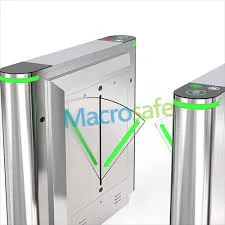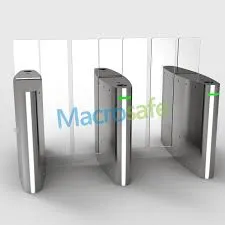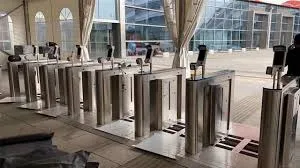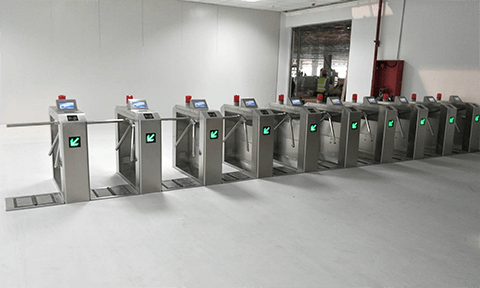Today, proper security for entrances to office buildings, lobbies, and other busy locations is as important as ever. One of the most efficient ways to control and restrict entry is by the use of lobby turnstiles. These systems are made to improve security levels and, at the same time, provide frictionless entry for authorized users. In this post, we will look at what lobby turnstiles are, how they function, the benefits of using turnstiles, and the reason behind the increased adoption of these systems all over the world.
What Are Lobby Turnstiles?
Lobby turnstiles are security measures that use the “one in, one out” principle to allow passage to unrestricted users while preventing access to restricted zones. They are commonly placed at the entry points of office buildings, terminals, and other areas that need access control. The most common form of turnstiles consists of a rotating arm or full-height barriers that physically restrain unauthorized individuals from gaining entry while allowing those with valid access to use the turnstile.
Key Features of Lobby Turnstiles:
- System Integration: Most lobby turnstiles are built to integrate with card readers, biometric scanning systems, and even facial recognition systems.
- Automatic Operation: Many models of lobby turnstiles open automatically when the relevant authorization is provided, making getting through fast and easy.
Offices today have completely turned to automated machine installations like lobby turnstiles. Although these existed earlier too, recent developments have made them immensely popular. This can be owed to high security against unwanted entry and easy accessibility for authorized personnel.
BDC lobby turnstiles transform the aesthetic appeal of modern office buildings while maintaining effective security measures. The advantages of having turnstiles in offices, along with aesthetic appeal, include:
- Streamlined Security: Turnstiles make access control and security measures easy while maintaining security protocols.
- Enhanced User Experience: Authorized users can access the premises without delays or distractions.
- High Customizability: Various designs and sizes make it easier to match the turnstiles with modern office designs.
Having these measures makes sure that the turnstiles remain effective in securing entry points for every business.

1. Heightened Security
Lobby turnstiles were created to restrict entry to authorized users only. They can be coordinated with many security measures such as:
- Card access readers
- Biometric scanners
- Facial recognition systems
These features guarantee that only authorized users are permitted access, while others are forbidden. This significantly lowers the risk of unauthorized access, particularly in locations that require maximum security.
2. Enhanced Control Over Pedestrian Flow
Lobby turnstiles can facilitate the flow of people to and from places that attract a lot of foot traffic, such as office premises and even train stations. Their automatic functions allow people to access the premises without wasting too much time, contributing to the need for efficiency. This is beneficial in busy areas, so long queues wouldn’t be a bother or problem for people and the entire system.
3. Strength and Inexpensive Servicing
Lobby turnstiles that are efficient should be energy-efficient and aim to provide services over a longer period at a reasonable and affordable cost. Their strong construction, which includes stainless steel or strong plastic material, makes them resistant to overuse and damage. Therefore, over a longer period of time, they tend to be more cost-friendly, especially compared to the current use of traditional security gates or manual checks.
4. Aesthetic Appeal
Lobby turnstiles can be quite appealing for not only their use but also how they look. Their modern designs can fit seamlessly into the overall structure. Most turnstiles are enhanced with glass barriers or LED lights, giving them a clean, advanced appearance that complements the design of modern offices.
The Installation Process of Lobby Turnstiles
Bear in mind that these turnstiles are straightforward to install; however, specific steps should be considered to ensure that the best product is received as recommended by the manufacturer.
Step 1: Select the Right Turnstile
Decide which turnstile is best suited for the building first. Keep in mind issues such as:
- Security checks
- Estimated number of users
- Design and shape of the building
Step 2: Secure the Turnstile
The turnstile should be attached firmly to the ground. This generally involves bolting the system in place using expansion screws. Some designs have been made to allow for non-permanent installation, which is ideal for events or short-term uses.
Step 3: Connect the Wiring
After the turnstile has been installed, make sure to integrate it with the building’s access control system. This entails connecting the turnstile to card readers, biometric systems, or surveillance cameras.
Step 4: Test and Adjust
Once the installation process is complete, the turnstile needs to be tested to ensure that all its features operate correctly. Verify that the system works well with other security features deployed and make adjustments as needed.

Statistical Information: Lobby Turnstile Use as a Component of Building Security
The need for turnstile security systems, including lobby turnstiles, is on the rise. MarketsandMarkets data suggests that the turnstile market is projected to rise from $2.3 billion in 2020 to $3.4 billion by 2025, resulting in a compound annual growth rate (CAGR) of 8.3%. This growth is due to the increasing need for automated security solutions and the challenges posed by urbanization, which brings many people needing effective security measures.
Moreover, Statista reports that more than half of commercial properties use some kind of turnstile access control. This demonstrates how imperative it has become for industries to adopt effective security measures like lobby turnstiles in busy places.
Types of Lobby Turnstiles

Different types of lobby turnstiles exist in the market to fit various requirements.
1. Tripod Turnstiles
This type of turnstile is very common and ideal for moderate foot traffic areas with an emphasis on security. It consists of three rotating arms, sometimes activated with a card or biometric scan.
2. Full-Height Turnstiles
More secure than tripod turnstiles, this type extends from the floor to the ceiling, thus preventing any over-the-top attempts to cross. This type is best suited for places where unauthorized access is not permitted.
3. Optical Turnstiles
Usually adopted in places with subtle security systems, this type serves three purposes simultaneously: it looks modern, serves as a barrier, and permits entry to authorized personnel via infrared sensors when a valid credential is presented.
Conclusion
Lastly, the benefits of having modern turnstiles, like the lobby ones mentioned above, that are encased in glass from the center and above, range from improving security measures to bettering traffic flow, making them a wise investment for businesses and offices.
Are you wondering whether lobby turnstiles suit the security needs of your premises?










